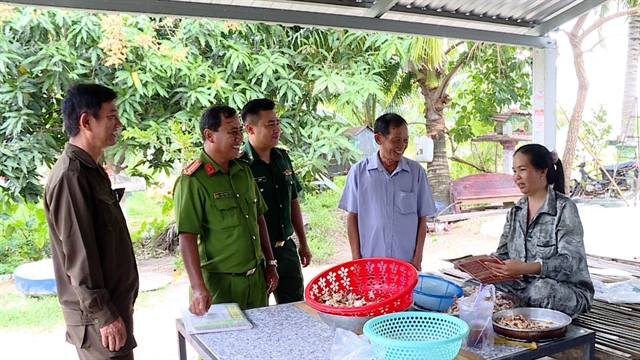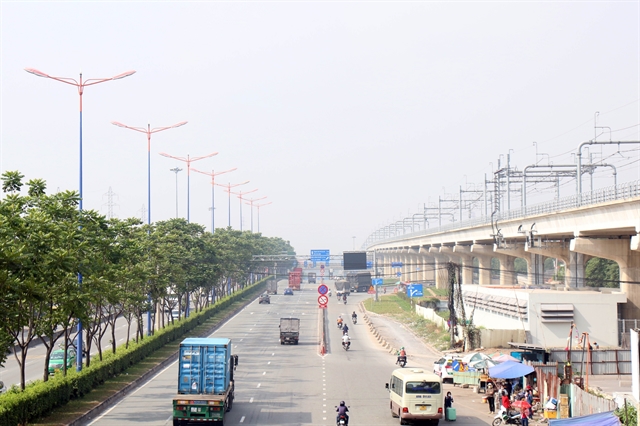 Society
Society


|
| There is significant potential for implementing the TOD model along HCM City's metro line No 1 between Bến Thành Market in District 1 and Suối Tiên Theme Park in Thủ Đức City. — VNA/VNS Photos Tiến Lực |
HCM CITY — Transit-Oriented Development (TOD) is key to attracting investment for major transportation projects in HCM City, helping to eliminate bottlenecks that hinder the city's development, urban transport experts have said.
These bottlenecks come mainly from inadequate transportation infrastructure that fails to meet actual needs, as well as limited investment, resulting in many projects not being implemented or being slowed down in their implementation, they said.
According to the city’s master plan for transport infrastructure development in the period of 2020-2030, HCM City needs an investment of approximately VNĐ970.6 trillion (US$42.3 billion). About VNĐ399.7 trillion would be funded by the State budget and the remaining VNĐ571 trillion would have to come from other sources.
They also estimated the total budget for priority infrastructure development projects in HCM City in the period of 2022-2025 to reach VNĐ243 trillion. Of that, investment in metro construction was estimated at VNĐ103 trillion, accounting for up to 43 per cent of the total.
However, the annual budget approved for urban infrastructure projects this year was just VNĐ30 trillion.
Bùi Xuân Nguyện, deputy director of HCM City’s Urban Railway Management Board’s Investment Preparation Committee said as of now, the mobilised ODA funds for urban railway construction projects in HCM City, including ongoing and future projects, amounted to approximately US$6.54 billion, which was only about 25 per cent of the estimated total investment.
The total amount of ODA funds mobilised from 2016 to 2020 decreased by 51 per cent compared to the period from 2011 to 2015, and was forecast to continue decreasing in the period from 2021 to 2025.
Many experts assessed that TOD was the key as well as a massive financial resource to develop and transform the urban landscape in the city based on existing infrastructure.
Solving funding issue
Nguyễn Trọng Hoài, an expert from HCM City University of Economics and Finance said the TOD model would maximise the utilisation of land and space around metro stations and enhance the value of the areas surrounding the stations.
The model would provide low-cost public and convenient transportation for residents. Integrated urban functions would create pedestrian-friendly streets, improving the health of citizens and reducing car usage and traffic congestion.
Hoài said as the metro rail system expanded, the urban space would develop accordingly. With urban development, the city could generate revenue from the urban development in those areas as a form of "space tax," which was the difference between transportation development and the development of the surrounding urban area.
This would be revenue gained by the State, he said, adding that in the past, the Government invested in infrastructure development without receiving contributions from those who benefited.
During the discussions at the fifth session of the 15th National Assembly, Chairman of the city’s People's Committee Phan Văn Mãi said that the city proposed a new resolution, in which the city would have the authority to decide how to use land around the metro lines.
As the new resolution was approved, the city now have mechanisms and policies to concentrate on mobilising resources. These resources included social investment through structures such as PPP (Public-Private Partnership), BOT (Build-Operate-Transfer), BT (Build-Transfer), TOD models, or policies that enabled HCM City to mobilise resources through issuing bonds.
"If we manage to mobilise these resources effectively, I believe that the city will be able to attract hundreds of trillion of đồng for development investment in the next five years," he affirmed.
Nguyễn Khắc Quốc Bảo, another expert from HCM City University of Economics and Finance said to attract capital resources, the city needed to take measures such as reviewing and adjusting land use planning, infrastructure planning for services, high-tech industries, agricultural technology, port systems, and logistics.
At the same time, the preparation and allocation of land for investors should be improved and changed. The pilot of the development of integrated urban areas using both domestic and foreign resources, as well as State and private resources should be carried out, he added.
Experts said that the development experiences of major cities worldwide such as Tokyo, Seoul, Singapore, and London showed that utilising land resources through the TOD model is a sustainable and long-term solution, especially for funding the development of urban rail networks.
Therefore, HCM City should focus on piloting this model in conjunction with urban planning in the vicinity of metro stations.
From theory to practice
In early June, the Government issued Resolution 87/NQ-CP on the Government's Action Programme to implement Resolution 31-NQ/TW dated December 30, 2022, on the orientation and tasks for developing HCM City by 2030 with a vision toward 2045.
It highlighted the study and development of the city centre, new urban areas, and areas surrounding metro stations following the TOD model.
However, experts said the implementation of the TOD model would require a long timeframe and high costs. The city requires a significant amount of preparation.

|
| The HCM City National University Station along the Bến Thành – Suối Tiên metro line still has lacks adequate funding. |
Shin Kimura of the Urban Renaissance Agency shared that in Japan the main resources for development come from businesses and government support.
The government needed to re-plan land use and enhance infrastructure to increase property values. Land acquisitions from residents must follow an appropriate mechanism that ensures fair benefits for all parties involved.
This allowed the government to have additional space to implement public projects while also improving the urban landscape and generating substantial finances for railway development.
Major cities in Việt Nam suffer from congestion from millions of personal vehicles, so it's necessary to disseminate the benefits of public transportation and establish regulations to ensure the equitable sharing of benefits among participating parties when implementing the TOD model.
Nguyễn Quốc Hiển, deputy head of the HCM City’s Urban Railway Management Board said there should be a leading agency to develop TOD in the city.
He cited the Urban Renaissance Agency in Japan as an example. The agency was entrusted with planning and developing both internal areas and areas outside and around the metro stations. This created conditions for urban development and provided financial resources to develop urban railway projects.
Currently, HCM City is implementing the transport infrastructure development plan for the period of 2020-2030. The Department of Transport is coordinating with other departments and districts to study and propose urban development planning in line with the public transportation (TOD model).
The city will be the first to implement the TOD model, which can also be applied in other localities across the country. — VNS